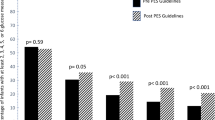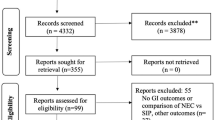Abstract
Objective:
To assess the safety and efficacy of early amino acid (AA) administration in preterm neonates <28 weeks gestational age.
Study design:
Prospective data collection for 1 year for the late AA group (AA started at 12–30?h) and for another year with practice change to early AA administration (immediately after stabilization).
Results:
Time of initiation of AA differed (early group 4±3?h vs late group 20±6?h; P<0.001). There were no statistically significant differences in the incidence of clinically significant metabolic acidosis. Blood urea at 24?h was higher in the early AA group. No significant differences in growth rate or neonatal outcomes were identified. Days to regain birth weight and sepsis were lower in the early AA group.
Conclusions:
Early AA administration was not associated with any clinically significant adverse effects; it was associated with reduction in the incidence of sepsis and marginally effective in reducing time to regain birth weight.
This is a preview of subscription content, access via your institution
Access options
Subscribe to this journal
Receive 12 print issues and online access
$259.00 per year
only $21.58 per issue
Buy this article
- Purchase on Springer Link
- Instant access to full article PDF
Prices may be subject to local taxes which are calculated during checkout
Similar content being viewed by others
References
Carlson SJ, Ziegler EE . Nutrient intakes and growth of very low birth weight infants. J Perinatol 1998; 18: 252–258.
Clark RH, Thomas P, Peabody J . Extrauterine growth restriction remains a serious problem in prematurely born neonates. Pediatrics 2003; 111: 986–990.
Cooke RJ, Ainsworth SB, Fenton AC . Postnatal growth retardation: a universal problem in preterm infants. Arch Dis Child Fetal Neonatal Ed 2004; 89: F428–F430.
Ehrenkranz RA . Growth outcomes of very low-birth weight infants in the newborn intensive care unit. Clin Perinatol 2000; 27: 325–345.
Embleton NE, Pang N, Cooke RJ . Postnatal malnutrition and growth retardation: an inevitable consequence of current recommendations in preterm infants? Pediatrics 2001; 107: 270–273.
Berry MA, Abrahamowicz M, Usher RH . Factors associated with growth of extremely premature infants during initial hospitalization. Pediatrics 1997; 100: 640–646.
Hay Jr WW, Lucas A, Heird WC, Ziegler E, Levin E, Grave GD et al. Workshop summary: nutrition of the extremely low birth weight infant. Pediatrics 1999; 104: 1360–1368.
Cooke RJ, Ford A, Werkman S, Conner C, Watson D . Postnatal growth in infants born between 700 And 1500 G. J Pediatr Gastroenterol Nutr 1993; 16: 130–135.
Adamkin DH . Pragmatic approach to in-hospital nutrition in high-risk neonates. J Perinatol 2005; 25 (Suppl 2): S7–S11.
Heird WC, Dell RB, Driscoll Jr JM, Grebin B, Winters RW . Metabolic acidosis resulting from intravenous alimentation mixtures containing synthetic amino acids. N Engl J Med 1972; 287: 943–948.
Johnson JD, Albritton WL, Sunshine P . Hyperammonemia accompanying parenteral nutrition in newborn infants. J Pediatr 1972; 81: 154–161.
Ibrahim HM, Jeroudi MA, Baier RJ, Dhanireddy R, Krouskop RW . Aggressive early total parental nutrition in low-birth-weight infants. J Perinatol 2004; 24: 482–486.
Te Braake FW, Van Den Akker CH, Wattimena DJ, Huijmans JG, Van Goudoever JB . Amino acid administration to premature infants directly after birth. J Pediatr 2005; 147: 457–461.
Shennan AT, Dunn MS, Ohlsson A, Lennox K, Hoskins EM . Abnormal pulmonary outcomes in premature infants: prediction from oxygen requirement in the neonatal period. Pediatrics 1988; 82: 527–532.
Bell MJ, Ternberg JL, Feigin RD, Keating JP, Marshall R, Barton L et al. Neonatal necrotizing enterocolitis. Therapeutic decisions based upon clinical staging. Ann Surg 1978; 187: 1–7.
Kramer MS, Platt RW, Wen SW, Joseph KS, Allen A, Abrahamowicz M et al. A new and improved population-based Canadian reference for birth weight for gestational age. Pediatrics 2001; 108: E35.
Thureen PJ . Early aggressive nutrition in the neonate. Pediatr Rev 1999; 20: E45–E55.
Thureen PJ, Hay Jr WW . Intravenous nutrition and postnatal growth of the micropremie. Clin Perinatol 2000; 27: 197–219.
American academy of pediatrics committee on nutrition: nutritional needs of low-birth-weight infants. Pediatrics 1985; 75: 976–986.
Nutrient Needs And Feeding Of Premature Infants. Nutrition Committee, Canadian Paediatric Society. CMAJ 1995; 152: 1765–1785.
Thureen PJ, Melara D, Fennessey PV, Hay Jr WW . Effect of low versus high intravenous amino acid intake on very low birth weight infants in the early neonatal period. Pediatr Res 2003; 53: 24–32.
Porcelli Jr PJ, Sisk PM . Increased parenteral amino acid administration to extremely low-birth-weight infants during early postnatal life. J Pediatr Gastroenterol Nutr 2002; 34: 174–179.
Van Goudoever JB, Colen T, Wattimena JL, Huijmans JG, Carnielli VP, Sauer PJ . Immediate commencement of amino acid supplementation in preterm infants: effect on serum amino acid concentrations and protein kinetics on the first day of life. J Pediatr 1995; 127: 458–465.
Wilson DC, Cairns P, Halliday HL, Reid M, Mcclure G, Dodge JA . Randomised controlled trial of an aggressive nutritional regimen in sick very low birthweight infants. Arch Dis Child Fetal Neonatal Ed 1997; 77: F4–F11.
Hack M, Merkatz IR, Gordon D, Jones PK, Fanaroff AA . The prognostic significance of postnatal growth in very low-birth weight infants. Am J Obstet Gynecol 1982; 143: 693–699.
Heird WC . The importance of early nutritional management of low-birth weight infants. Pediatr Rev 1999; 20: E43–E44.
Lucas A, Morley R, Cole TJ, Gore SM, Lucas PJ, Crowle P et al. Early diet in preterm babies and developmental status at 18 months. Lancet 1990; 335: 1477–1481.
Lucas A, Morley R . Does early nutrition in infants born before term programme later blood pressure? BMJ 1994; 309: 304–308.
Lucas A . Long-term programming effects of early nutrition – implications for the preterm infant. J Perinatol 2005; 25 (Suppl 2): S2–S6.
Andronikou S, Hanning I . Parenteral nutrition effect on serum insulin in the preterm infant. Pediatrics 1987; 80: 693–697.
Author information
Authors and Affiliations
Corresponding author
Rights and permissions
About this article
Cite this article
Kotsopoulos, K., Benadiba-Torch, A., Cuddy, A. et al. Safety and efficacy of early amino acids in preterm <28 weeks gestation: prospective observational comparison. J Perinatol 26, 749–754 (2006). https://doi.org/10.1038/sj.jp.7211611
Received:
Revised:
Accepted:
Published:
Issue Date:
DOI: https://doi.org/10.1038/sj.jp.7211611
Keywords
This article is cited by
-
Does High Protein Intake During First Week of Life Improve Growth and Neurodevelopmental Outcome at 18 months Corrected Age in Extremely Preterm Infants?
The Indian Journal of Pediatrics (2016)
-
Impact of renal function and protein intake on blood urea nitrogen in preterm infants in the first 3 weeks of life
Journal of Perinatology (2015)
-
The International Network for Evaluating Outcomes of very low birth weight, very preterm neonates (iNeo): a protocol for collaborative comparisons of international health services for quality improvement in neonatal care
BMC Pediatrics (2014)
-
Validating the weight gain of preterm infants between the reference growth curve of the fetus and the term infant
BMC Pediatrics (2013)
-
SCAMP: standardised, concentrated, additional macronutrients, parenteral nutrition in very preterm infants: a phase IV randomised, controlled exploratory study of macronutrient intake, growth and other aspects of neonatal care
BMC Pediatrics (2011)



